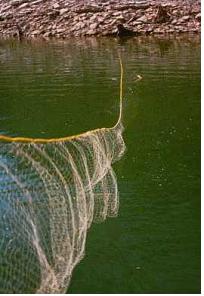|
Passive Gears
Gill or Fixed nets

Gill Net
Gill nets are walls of netting
which may be set at or below the surface, on the seabed, or at any depth in between.
Gill netting is probably the oldest form of net fishing, having been in use for
thousands of years. True gill nets catch fish that attempt to swim through the net,
which are caught if they are of a size large enough to allow the head to pass through
the meshes but not the rest of the body. The fish then becomes entangled by the
gills as it attempts to back out of the net. The mesh size used depends upon the
species and size range being targeted.
Trammel nets are a wall of
net divided into three layers. An inner fine-meshed net is sandwiched between two
outer, larger meshed nets. The net is anchored at the base and floated by the headline,
allowing it to hang vertically. The inner net is looser than the outer ones, ensuring
that the fish become entangled within it.
Tangle nets resemble gill nets
but are slacker, shorter and have less flotation. This results in a looser-hung
net that entangles species rather than gilling them.
Although static gears such as gill nets generally have less impact on the environment
than mobile or towed gears they pose a particular problem for cetaceans (dolphins
and porpoise). Methods to increase the ‘dolphin-friendliness' of this fishing
method include the attachment of acoustic devices or ‘pingers' to the net
to deter the animals; reducing the ‘soak time'; i.e. the amount of time the
net is left in the water;restrictions on the length of net used; and the introduction
of closed areas to exclude fishermen from cetacean 'hot-spots'.
Long-lining
Long-lining is one of the most fuel-efficient catching methods. This method is used
to capture both demersal and pelagic fishes including swordfish and tuna. It involves
setting out a length of line, possibly as much as 50-100 km long, to which short
lengths of line, or snoods, carrying baited hooks are attached at intervals. The
lines may be set vertically in the water column, or horizontally along the bottom.
The size of fish and the species caught is determined by hook size and the type
of bait used.
Pole and line
Pole and line
Pole and line fishing (also known as bait boat fishing) is used to catch naturally
schooling fish which can be attracted to the surface. It is particularly effective
for tunas (skipjack and albacore). The method almost always involves the use of
live bait (anchovies, sardines etc.) which is thrown over board to attract the target
species near the boat (chumming). Poles and lines with barbless hooks are then used
to hook the fish and bring them on board. Hydraulically operated rods or automatic
angling machines may be used on larger pole and line vessels.
Jigging
Jigging is widely used to capture squid. A jig is a type of grapnel, attached to
a line, which may be manually or mechanically jerked in the water to snag the fish
in its body. Jig fishing usually happens at night with the aid of light attraction.
Trap (nets)
Fish Traps
Walls or compounds of netting are set out in a particular way and anchored to the
seabed so that fish, once they have entered, are prevented from leaving the trap.
In some cases, e.g. salmon traps, long leader nets are arranged from the shore to
intercept migrating fish and guide them into the trap. Other species taken in traps
include bass, herring and tuna.
The selectivity of trap nets is determined by the mesh size used. Undersized or
unwanted fish may be returned to the sea alive. However, in many tropical or subtropical
fisheries where there is a large mix in species and size range, many fish are likely
to become gilled as they attempt to escape from the trap. Seabirds and mammals are
also prone to becoming entangled in the nets.
Fish attraction devices (FADs)
Various species of fish often congregate or associate with other living creatures
(e.g. tuna associate with dolphins and whale sharks) or objects floating or suspended
in the sea. This natural phenomenon has been exploited to attract fish to floating
or suspended structures. Such structures can provide known locations for congregating
fish, around which vessels can operate a wide range of fishing techniques including
purse seines, pole and line or trolling. FADs may be used to concentrate fish in
sufficiently high numbers which are then surrounded with a purse seine net. Fishermen
using pole and line or trolling methods may use the boat from which they are fishing
as a FAD.
Top
|